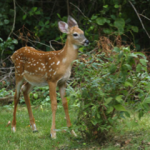 Many of our treasured plants succumb to insect and disease problems in the long hot, humid summer. As herbaceous plants die back to the ground for the winter, and deciduous trees and shrubs lose their leaves, we get a break from many pest and disease problems. Nourishment for wildlife, however, is more limited, and can pose a particular challenge. With green material at a premium in winter, deer may attack your evergreens with a vengeance. While it is said that deer may eat anything if they are hungry enough, there are certain plants that have proven more deer resistant, and much of my practice is devoted to recommending and installing those I have personally tested.
Many of our treasured plants succumb to insect and disease problems in the long hot, humid summer. As herbaceous plants die back to the ground for the winter, and deciduous trees and shrubs lose their leaves, we get a break from many pest and disease problems. Nourishment for wildlife, however, is more limited, and can pose a particular challenge. With green material at a premium in winter, deer may attack your evergreens with a vengeance. While it is said that deer may eat anything if they are hungry enough, there are certain plants that have proven more deer resistant, and much of my practice is devoted to recommending and installing those I have personally tested.
Many plants are unequivocally deer candy (Hostas, Yews); others will be tested during winter when food supplies are limited. Deer repellents can be effective if used properly and on a selected basis. I have found Bobbex to be an effective spray product; there are many others. These products need to be applied at intervals according to the directions. I have also found Milorganite, a granular organic fertilizer spread on the ground at the plant’s base, to be very effective, even after rainfall. Use of such products can be cumbersome and unrealistic for many. Knowing the creature’s habits can help with selective treatments. For example, deer tend to relish tender new growth (flower and leaf buds), so applications at such time can be very productive. An extended cold spell during a particular winter can suddenly lead the deer to sample many plants they’d previously avoided. In such times, beefing up use of deer repellents on those evergreens that are questionably deer resistant, makes sense. If the best deer deterrent – complete, sufficiently tall fencing – is not feasible, other physical barriers can be used selectively. For example, you might toss light deer netting over plants that may not be foolproof. Barrier plantings such as thick stands of ornamental grasses with sharp blades that deter deer, can be placed around plants that the deer are consuming.
JUL
2012
